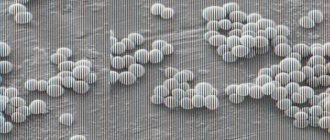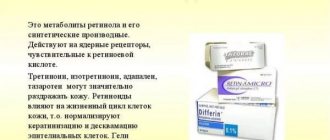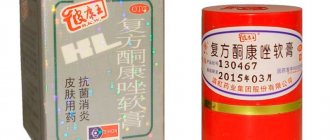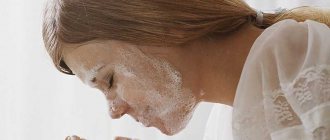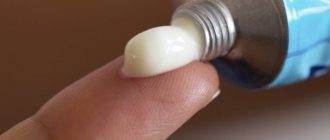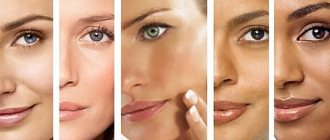What is antibiotic ointment
Antibiotic ointment for skin inflammation is an effective medicine that is used to treat various diseases caused by microorganisms. Its distinctive feature is its low level of absorption compared to intramuscular injections. A small dose of the active substance penetrates the blood and spreads throughout the body.
This fact should be taken into account by those who have kidney and liver diseases. Infections that threaten a person’s life require hospital treatment. Long-term use of such drugs can develop adverse reactions in the form of indigestion, bloating, and dysbacteriosis.
Antibiotic ointment is not used for symptomatic treatment and is prescribed only by a doctor. You cannot interrupt the course of treatment and leave the bandage with ointment on for more than 12 hours, this contributes to the formation of resistant bacteria, which will lead to the progression of the disease.
Types of blepharitis
Depending on the pathogen that caused inflammation of the eyelids, the disease is divided into types. Based on the etiology, treatment is prescribed. It can take quite a long period - from two weeks to two months or more. That is why, when signs of blepharitis appear, you need to visit a doctor for a diagnosis and begin surgical treatment.
Allergic blepharitis
It usually occurs during the flowering period of plants, and can also be triggered by cosmetics, household chemicals and other irritants. Sometimes this type also includes drug-induced blepharitis, which occurs as a result of taking medications (externally or internally).
Seborrheic or scaly blepharitis
The most common form of the disease. Yellowish scales form in the space between the eyelashes, profuse lacrimation appears, and a sticky secretion is released from the excretory ducts, gluing the eyelashes together. As the disease progresses, seborrheic dermatitis may also develop in different parts of the head.
Ulcerative blepharitis
A severe form of the disease, usually difficult to treat. As it progresses, pus is released, ulcers form on the hair follicles, and eyelashes begin to fall out. After recovery, their proper growth may be disrupted, and traces of ulcers may remain.
Meibomian blepharitis
It occurs due to the entry of Staphylococcus aureus into the meibomian glands at the base of the eyelashes. They become clogged with sticky, viscous secretion, the edges of the eyelids become red and inflamed, and purulent blisters form on them. After opening them, small scars remain, which disappear some time after complete recovery.
Demodectic blepharitis
The causative agent of this form of the disease is the Demodex mite. Sebaceous secretions and particles of the epidermis accumulate at the edge of the eyelashes. With demodectic inflammation of the eyelids, severe itching and burning occurs, especially in the morning after waking up.
Depending on the location of the lesions, blepharitis is divided into three categories:
- anterior marginal, in which the inflammatory process affects the edges of the eyelids along the ciliary row;
- posterior marginal, extending to the meibomian glands;
- angular, in which inflammation occurs in the corners of the eyes.
If you do not contact a specialist in a timely manner or if the treatment regimen is not followed, blepharitis of the eyelids can go from a chronic stage to an acute one. Effective therapy requires strict adherence to medical recommendations and taking prescribed medications, as well as adherence to the rules of personal hygiene and diet during illness.
Classification of ointments for skin inflammation
All types of antibiotic ointments are divided into combined and simple ones. In combination preparations, in addition to the antibiotic, there are other active substances that act comprehensively on the painful area. In simple types of ointments, the active substance is only an antibiotic.
In addition, antibiotic drugs differ in type of origin. There are natural, synthetic and semi-synthetic drugs. Each type of ointment is effective only against a specific bacterium.
Antibacterial agents are used for:
- treatment of skin areas caused by bacteria;
- skin injuries and burns;
- treatment of otitis media;
- eye diseases.
Symptoms of blepharitis
The development of the disease is characterized by the following clinical manifestations:
- thickening and redness of the ciliary edge of the eyelids;
- severe itching and irritation in the eyes;
- increased sensitivity to light;
- sticky discharge that sticks together eyelashes;
- the appearance of scales and crusts;
- eyelash loss;
- eye fatigue even with low visual load.
The listed symptoms are characteristic of many types of blepharitis. For effective therapy, you must strictly adhere to the doctor’s recommendations, maintain personal hygiene and the prescribed treatment regimen.
Top 10 antibiotic ointments for skin inflammation from the pharmacy
A doctor should prescribe an antibiotic ointment, taking into account the nature of the disease, the location of the infection and its size. Below is a list of popular pharmacological drugs with antibiotics.
Levomekol
A combined drug that has an anti-inflammatory, antimicrobial effect and is active against gram-negative and gram-positive microorganisms. The product quickly penetrates tissue without damaging biological membranes and accelerates the healing process.
Lkvomikol is the most popular antibiotic ointment for skin inflammation.
The medicine contains diocosmethyltetrahydropyrimidone, which normalizes nucleic acid metabolism and stimulates healing in wounds. Also included is polyethylene oxide, which is necessary to enhance the main component of the drug. Levomekol ointment is used in surgery, therapy and dentistry. It eliminates pathogenic bacteria from the skin and mucous membranes.
Indications for use:
- burns of hands and feet;
- purulent wounds;
- furunculosis;
- trophic ulcers;
- sinusitis, sinusitis;
- inflammation of the mucous membrane;
- hemorrhoids.
The ointment is recommended for use against bedsores, as well as in the treatment of calluses, cuts and eczema. The medication is prescribed for a course of 14 days, applied to an open wound for 10 hours. If necessary, the ointment layer is renewed and the surface is treated with hydrogen peroxide before use.
In pediatrics, the drug has proven itself well. It is prescribed for the treatment of diaper rash, pustules and for the rapid healing of the navel in newborns.
Contraindications:
- psoriasis;
- fungus;
- eczema;
- intolerance to components.
Despite the extensive range of actions, Levomekol ointment costs between 120-150 rubles. and is sold freely in pharmacies.
Eplan
Antibiotic ointment for skin inflammation Eplan has a bactericidal and regenerating effect. The product is used for burns, cuts, abrasions, as its active substances promote the healing of diseased areas of the skin.
Contains:
- glycolan;
- distilled water;
- glycerol;
- ethylcarbital;
- polyethylene glycol.
When using the cream, it forms a “biological glove” on the skin, thereby accelerating the metabolic process of cells, renewing damaged areas of the skin.
The drug is prescribed for the following diseases:
- herpes;
- eczema;
- otitis;
- human papilloma virus.
For fungal diseases:
- mikaz;
- candidiasis.
For chronic skin diseases:
- bedsores;
- dermatitis;
- condyloma;
- psoriasis.
Eplan ointment is characterized by a wide range of applications and is prescribed after:
- insect bites;
- sunburn;
- sports injuries;
- cuts and abrasions.
Eplan is effective in gynecology, for example, for thrush.
Eplan is an indispensable drug for newborns:
- relieves inflammation;
- relieves pain;
- treats diaper rash and redness;
- accelerates healing.
Contraindications to the ointment include only intolerance to the components of the product. Eplan is applied to the affected area of skin and rubbed into the damaged area. The duration of treatment is up to 4 weeks, but the effect of treatment is visible within a couple of days. The product is sold in pharmacies without a prescription and costs around 150 rubles.
Nitacid
Nitacid is a combined agent that has an antimicrobial effect. The product contains nitazol and streptocide, which have an anti-inflammatory effect. The ointment dries wounds and has a cleansing effect due to its ability to absorb purulent masses.
Indications:
- infected wounds;
- bedsores;
- fistulas;
- burn wounds.
Nitacid is not used in case of hypersensitivity to the components of the drug, as well as in pediatrics. Before applying the product, you need to carry out a simple treatment. After application, cover the wound with sterile material. After surgery, fill the wound with tampons with ointment.
The duration of treatment should only be determined by a doctor.
For adults, ointment is prescribed once a day. The maximum single dose of Nitacid is 400 g. In dermatology, the medicine is used as an application to the damaged area, 1 or 2 applications per day. The product is sold freely in pharmacies and its price ranges from 140-200 rubles.
Streptoplaven
Antibiotic ointment Streptoplaven has anti-inflammatory and antimicrobial effects. The ointment stops necrotic processes on the skin and stimulates its healing. The product contains miramistin, which has high activity against gram-negative and gram-positive bacteria.
Quickly penetrating inside, the drug improves the therapeutic effect after several uses. The medicine does not require rubbing, which makes the process of use easier. Purulent wounds should be treated using medical wipes, which should be placed in the cleaned wound and replaced only once a day.
Indications:
- severe inflammatory process in the wound;
- abscess;
- trophic ulcer;
- phlegmon;
- gangrene.
Using the instructions for the drug and consulting a dermatologist, you can create an effective treatment regimen that will eliminate pathology in the tissues. Adults need to apply a thin layer of ointment 2-4 times a day. The duration of treatment is 3 weeks.
Children should apply the ointment no more than 2 times a day with a treatment duration of 1.5 weeks. Contraindications to the product include intolerance to the components and the occurrence of an allergic reaction. Streptoplaven is sold in pharmacies without a prescription and its cost ranges from 58-150 rubles.
Causes of blepharitis of the eyelids
Various factors can cause inflammation. The main one is Staphylococcus aureus, which gets into the hair follicles of the eyelashes. Today, from 25 to 40% of people in the world are its carriers.
Staphylococcus is present in the mucous membranes of the upper respiratory tract, as well as on the epidermis. Staphylococcal infection causes a wide range of diseases in humans, from skin infections to deadly meningitis, pneumonia, and sepsis. You should not treat blepharitis as a mild eye ailment that will quickly go away if you apply eye drops. Treatment may take a long period, especially if it is started late. Other causes of the disease can be bacterial and viral infections, mites. Allergic blepharitis occurs when various cosmetics, household liquids, and pollen from flowering plants come into contact with the mucous membrane of the eyes. Pet owners are also susceptible to demodectic blepharitis: it is caused by the Demodex mite that lives on the fur of their pets.
The cause of inflammation of the eyelids is visual impairment. Thus, blepharitis of the eyelids often occurs in people with farsightedness or astigmatism. The risk group includes people with general pathologies - diabetes, gastritis, cholecystitis, sinusitis, tonsillitis, etc. Weakened immunity, sensitive and dry organs of vision, chronic intoxication, vitamin deficiency can also cause the disease.
Complications of purulent wounds
A predisposing factor to the development of complications is that the purulent wound was treated incompletely or completely absent. This is fraught with the development of the following consequences:
| Complication | Description |
| Lymphangitis | Inflammation of the lymphatic vessels in the area above the wound. |
| Lymphadenitis | Inflammation of regional lymph nodes. |
| Sepsis | Blood poisoning is dangerous and fatal. |
| Abscesses and cellulitis | Purulent-inflammatory processes in soft tissues. |
| Osteomyelitis | Inflammation of bone tissue. |
| Thrombophlebitis | Inflammation of the veins and the formation of blood clots - thrombi. |
Physiotherapy for the treatment of blepharitis
If the disease is acute or the prescribed medications have a very slow effect, additional physical therapy may be prescribed. The procedures help eliminate inflammation and redness of the eyelids, help improve metabolic processes, and accelerate the regeneration of damaged tissues. For treatment use:
- UHF therapy;
- darsonvalization - exposure to high-frequency pulsed currents;
- electrophoresis;
- magnetic therapy and other methods.
Washing the conjunctival cavity and applying compresses to the eyes has a good result. The list of necessary procedures is determined by the attending physician, and also regulates their duration and period of implementation.
What additional measures should be taken when treating blepharitis?
During therapy, you should adhere to certain rules that will help and speed up the result. It is important to follow a strict diet, excluding too spicy, salty, fatty, smoked foods, and alcohol from the diet. You need to consume more foods containing healthy vitamins - retinol, riboflavin, ascorbic acid, zinc, selenium:
- retinol - wild garlic, broccoli, garlic, viburnum berries, fish oil;
- riboflavin - beef liver, cod liver, quail eggs;
- vitamin C - citrus fruits, greens, sour berries;
- selenium - nuts, legumes, some cereals, for example, buckwheat;
- zinc - seafood (kelp, shrimp), as well as cheeses and soy.
By following a special diet that includes the consumption of these foods, you can significantly speed up the healing process. It will also be useful to drink vitamin complexes and dietary supplements for the eyes. Almost any infection is a consequence of a weak immune system, and it needs to be strengthened. You should also avoid spending long periods of time at the computer to prevent dryness and overstrain of the visual organs. During the treatment period, you need to change bed linen more often, especially pillowcases, and also get a separate towel for the patient. It is better to gently blot the affected eye with a disposable napkin after washing, and do not rub it with your hands. As a rule, blepharitis first occurs on one visual organ, and a person, not following hygiene rules, spreads the infection to the second. Women should avoid using decorative cosmetics. It can clog the excretory ducts, prevent the release of pus and increase inflammation. In addition, cosmetics during illness cause an allergic reaction in the eyes. It is also worth stopping wearing contact lenses during treatment and switching to glasses or completely abandoning correction during this time, if possible.
In addition to the fact that purulent discharge will accumulate on the lenses, they will be damaged by drops and ointments. The use of such optics is dangerous to the health of the visual organs. A large percentage of success in the treatment of blepharitis lies in observing simple hygiene rules and following the doctor’s recommendations.
What are the consequences of untimely treatment?
With improper or untimely treatment, blepharitis can develop into an acute form, and curing it in this situation will be much more difficult. For any manifestations that may be signs of blepharitis, you should consult a specialist as soon as possible. There is no need to diagnose yourself or look for advice on the Internet. Not only is this ineffective, but it can cause serious damage to your eyes. An ophthalmologist will determine the etiology of blepharitis, show how to properly perform hygienic treatment and eyelid massage, and prescribe effective medications.
If hygiene rules are violated or ointments and drops are used incorrectly, the disease can take a complex course, so the patient must comply with all prescriptions responsibly. If the prescribed treatment does not give a positive result for a long time and a relapse of the disease occurs, a comprehensive examination of the body is prescribed: perhaps the cause of the problem lies in general pathology.
Diagnosis of blepharitis
The main method of diagnosis is a thorough examination of the eyes using a slit lamp - this is called biomicroscopy. The ophthalmologist examines the edges of the eyelids, including their inner surface, assesses the condition of the excretory ducts at the base of the eyelashes, as well as the conjunctiva, cornea and other eye structures. In some situations, additional tests will be needed to make an accurate diagnosis: scraping the conjunctiva, examining eyelashes under a microscope for the presence of Demodex mites.
The ophthalmologist will measure visual acuity and evaluate the accommodative ability of the eyes. It also happens that the treatment does not bring the desired results, then a comprehensive examination of the patient is prescribed: perhaps the problem lies in the general pathology of the body, or is caused by cancer of the sebaceous glands.


